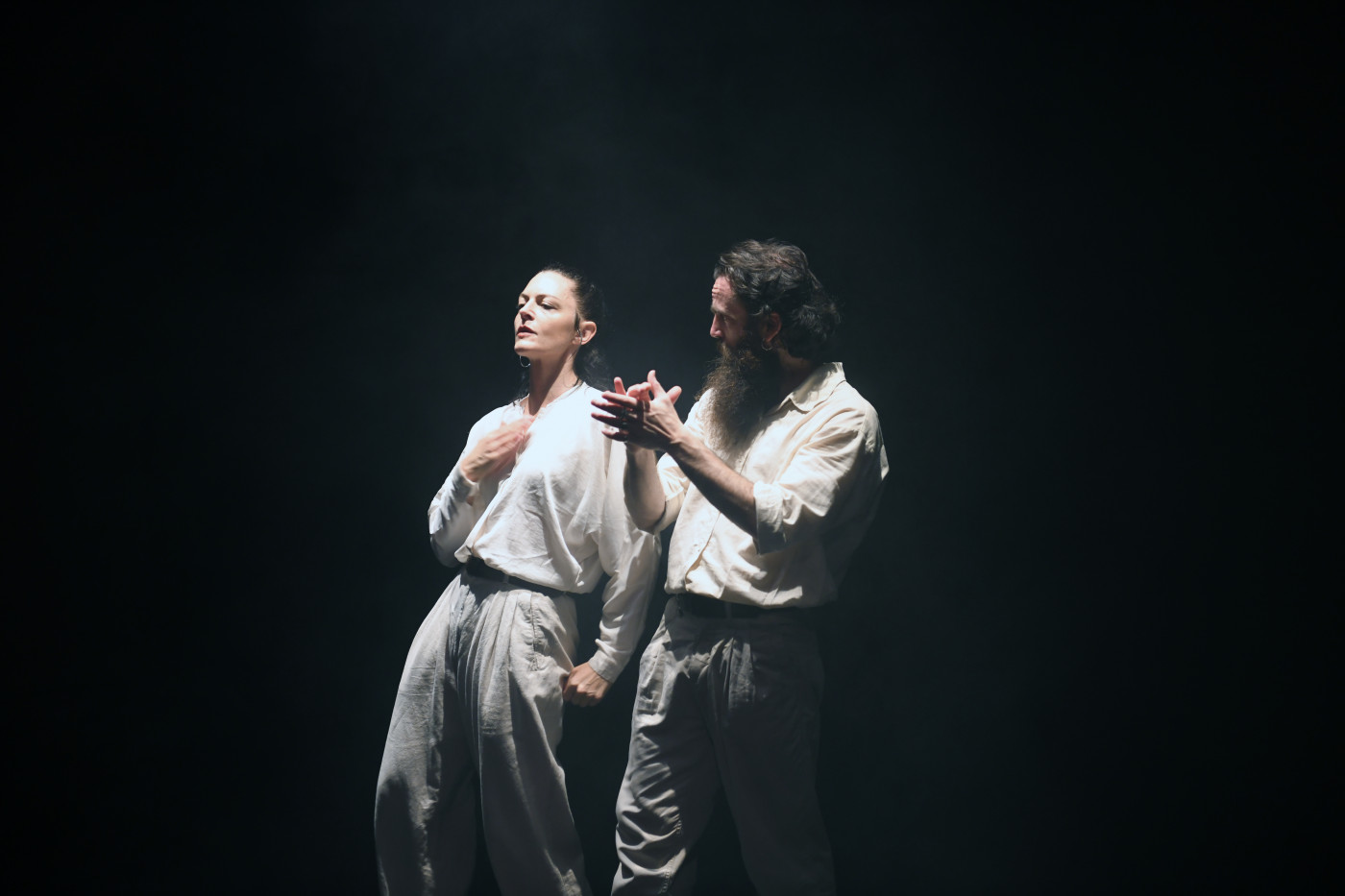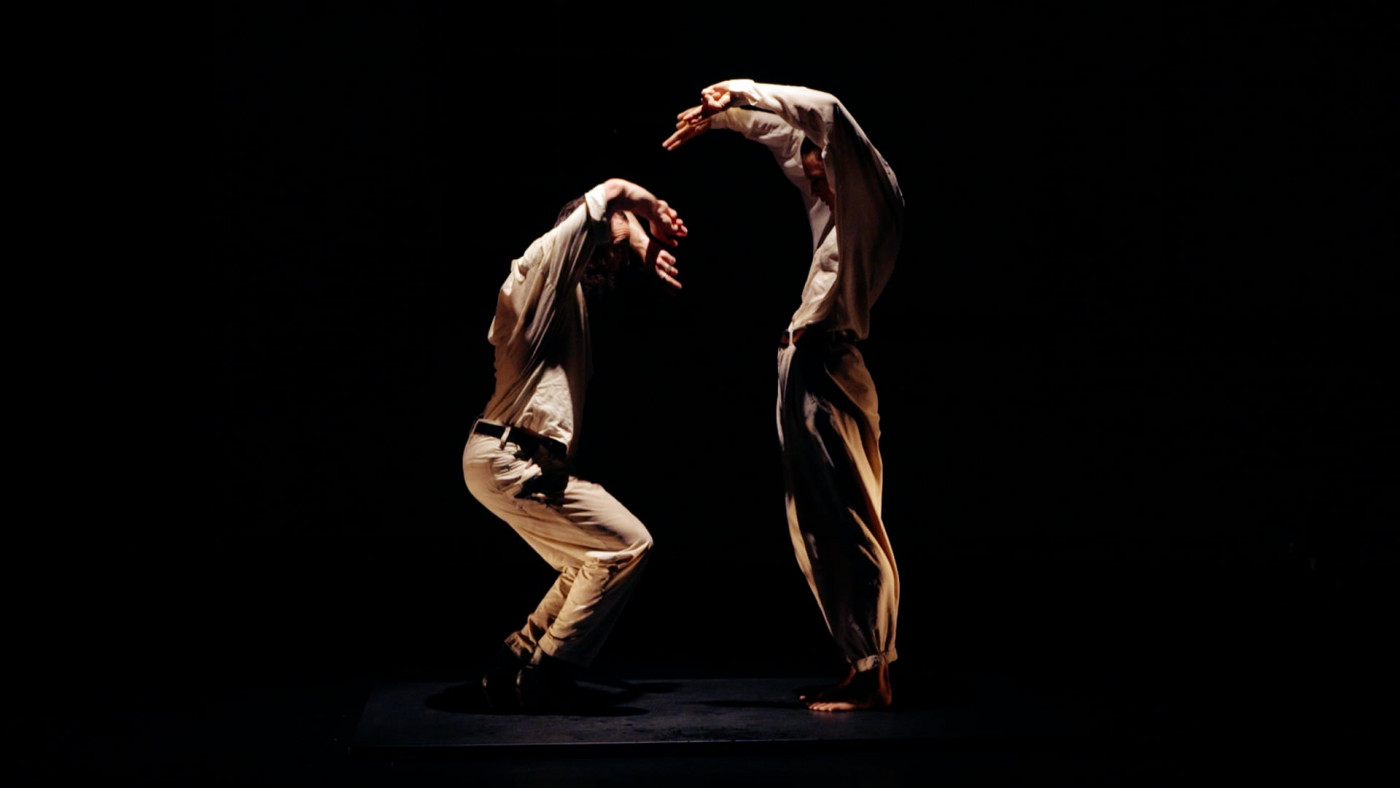
Impulse and Friction: A Contemporary Encounter with Flamenco
The space lies in twilight. A single lightbulb casts a diffuse glow onto the center of the stage – a simple, rectangular wooden platform that functions both as an isolating boundary and as an acoustic resonator. The two performers, Sita Ostheimer and Álvaro Murillo, begin to move in soft, fluid synchrony, with such minimal amplitude that their movements could almost be mistaken for stillness. The atmosphere is focused, almost ritualistic. It feels as if movement is not initiated from the outside, but rather pressed to the surface from within, against the resistance of the surrounding space.
The beginning of PULSE unfolds in quiet density and concentrated atmosphere. Movement does not emerge as a complete form but seems to slowly and gently arise from the tension between body and space – as if it was rising from a shared impulse that has not yet found its shape. Nothing feels preconceived or demonstrative; rather, movement reveals itself as a tentative search for physical presence.
Only gradually does it become apparent which tradition is being negotiated within the piece: that of flamenco. This engagement forms a vital subtext of the evening, yet it is not treated illustratively or ornamentally. What lies at the center is not affirmation, but deconstruction and transformation – a contemporary reimagining of tradition. As Sita Ostheimer and Álvaro Murillo put it: “Our work wasn’t about preserving flamenco or reshaping it. We didn’t approach flamenco as something fragile or sacred — we approached it as something alive, something that can move, break, rebuild, and breathe in other spaces.”
Gradually, the performers’ physical language becomes more expressive, without breaking the controlled tension. Their upper bodies remain centered, while the arms begin to trace wider arcs – not decorative gestures, but probing, searching movements. The air feels viscous, and movement within it heavy. The steps and footwork – at times slow and tight, at others forcefully expansive – remain nearly synchronized, yet with one crucial difference: Sita Ostheimer dances barefoot, Álvaro Murillo wears ankle boots. This creates an uneven distribution of protection and vulnerability, which manifests not only visually but also acoustically: it is Murillo who drives the rhythm forward, articulating it with his heavy, resonant steps and setting the sonic pace of the scene.
Their gaze gradually shifts more directly toward the audience – calm, but increasingly assertive and confrontational. A palpable tension emerges between the two performers. Closeness and distance are not gently balanced but negotiated through conflict. Touches are hinted at and withdrawn; the tension lies in the in-between. This is not a dialogue in the sense of action and reaction, but a mutual questioning – conveyed through minimal spatial shifts, through weight, breath, and impulse.
“The starting point was curiosity and trust — trusting that something would grow from the encounter itself,” Ostheimer and Murillo write in retrospect about the creation process.
What unfolds is not so much a linear dramaturgy but a sequence of physical states. PULSE works with friction, resistance, attraction, and dissolution. From the dense interaction between the two dancers, individual characteristics of flamenco gradually emerge: the expressive use of the arms, complex footwork, rhythmic clapping (palmas), finger snapping (pitos) – and, not least, the forceful verticality that defines flamenco. A verticality that eventually breaks down as the rhythm and the pounding feet push the performers to the edge of physical exhaustion. The small, clearly defined stage area – the wooden floor – is never abandoned. It defines the space of encounter: as a site of intimate concentration, but also of unavoidable confinement. Nothing opens outward – everything is negotiated within this tight, isolated frame.
In recent decades, flamenco and its performance practices have undergone significant transformation. There has been a shift away from the fixed stage, away from the tablao – the traditional flamenco venue, often a bar or small performance space where dance, singing, and guitar are performed live and in close proximity to the audience. Also left behind is the emphasis on technical virtuosity that once dominated flamenco. Contemporary flamenco artists such as Rocío Molina, Israel Galván, and Belén Maya understand it as an open, living archive – one that persists not only through preservation, but above all through critical inquiry and re-evaluation: of identity, origin, gender, the body – and the ways in which these are constructed in the present.
This shift in perspective redirects the focus: away from codified expression toward physically experienced impulse. Flamenco is no longer “performed” but physically processed – through friction, fragmentation, suspension, and repetition. And that is exactly what happens in PULSE: the bodies create spaces of experience. Movement does not aim at representation but for embodied presence. What matters is the tension it generates, the friction it provokes, the resistance it renders tangible — and the sweat it demands.
“What was essential was to stay honest: not to decorate, not to fuse, but to allow the contrasts to emerge naturally — weight and suspension, sharpness and fluidity, control and risk.
But more than contrasts, we found a big shared ground: instinct, presence, rawness, rhythm. These are not exclusive to flamenco or to contemporary forms — they are what connect us.”, they state.
PULSE does not deconstruct flamenco in order to dismantle it, but to expose it: as an energetic archive, as a form of expression beyond stylistic boundaries. The transformation is not a departure from tradition – which, from the beginning, held a subversive character – but an opening. Flamenco is not diluted, but reactivated and rearticulated as something alive: open to rupture, shifts, and new beginnings.
Berlin, 04/07/2025

By playing this video, you accept Vimeo´s privacy policy. Read more in our privacy policy and at https://vimeo.com/privacy.
